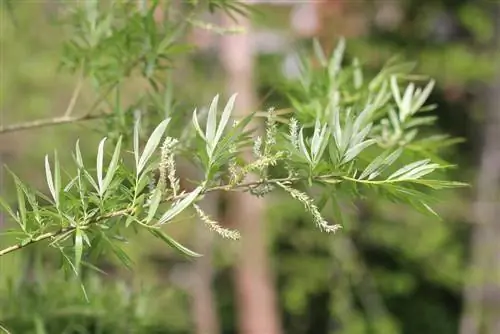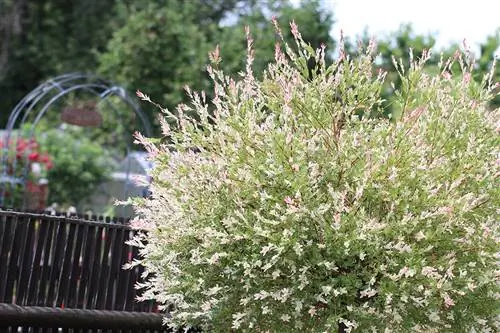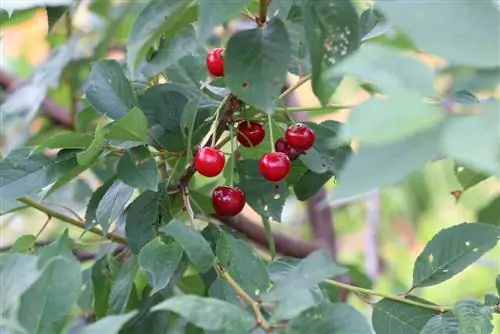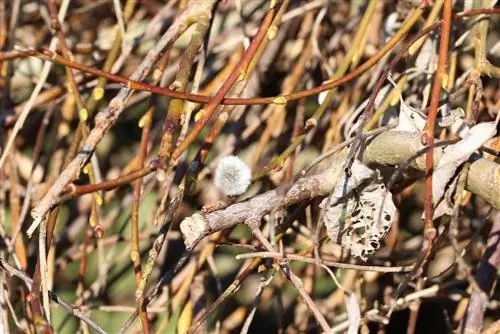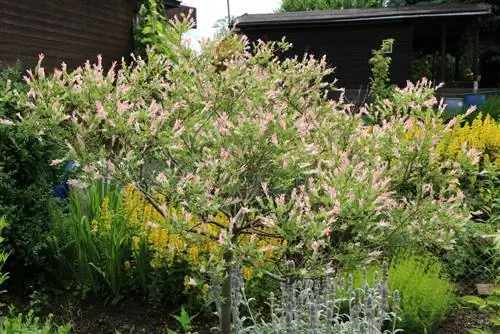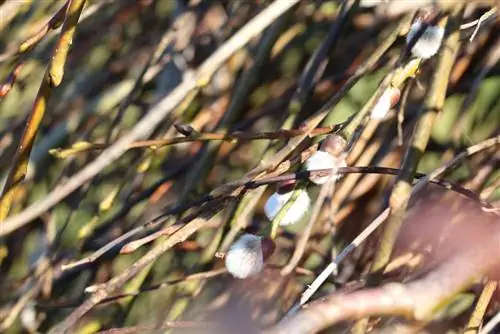- Author admin [email protected].
- Public 2023-12-17 03:39.
- Last modified 2025-01-24 12:45.
Willows such as osier are characterized by enormous growth and the ability to re-sprout from small pieces of branches and from trunks that have been almost completely cut down. They are among the pioneer plants that spread quickly and effectively into areas created by fires, erosion or other disasters. This makes osier a popular plant for hedges that are created to provide privacy or wind protection. Wicker trees are cultivated primarily because of their long, flexible branches for weaving all kinds of basketry.
Profile
- Botanical name: Salix viminalis
- other names: hemp willow, wattled willow, connective willow
- belongs to the willow family
- deciduous, upright shrub or small tree
- rod-like upright branches
- Leaves: lanceolate, up to 20 cm long
- Flowering: hairy buds, so-called catkins (3-4 cm) in March/April
- Growth height: 3-7 meters (rarely up to 10)
Location
Like other willows, the osier prefers wet and flooded areas and grows alone as a pioneer plant in many different soil conditions. It loves sunny locations and is also heat tolerant.
- Light requirements: very sunny
- Soil: sand, gravel, gravel, loam, clay
- light to medium humus content
- pH value: slightly acidic to alkaline (5, 5-8)
- hardy to -34 degrees
Good adaptation to the area of life
The roots of the osier can store oxygen in the spaces between the cells. This means it is able to compensate for a lack of oxygen even in times of flooding, soil compaction and waterlogging.
Watering and fertilizing
Salix viminalis copes well with changing moisture levels in the soil. It can easily survive waterlogging and short dry periods. Young plants require a lot of moisture and must therefore be watered regularly. The osier does not like extremely nutrient-poor or heavily fertilized soil. That's why it's only necessary to fertilize the willow with a little compost in the spring every two to three years.
Plants
A osier has a very strong ability to reproduce vegetatively. Even from the smallest pieces of branches it can form a whole tree again. This is why osiers are very easy to propagate through cuttings. Anyone who struggles with waterlogging or temporary flooding in the garden is well served with wicker. To prepare for planting - whether as a cutting or a purchased young plant - deep digging is sufficient. If the soil is very heavy, the earth is dug about two spades deep and all old roots and stones are removed, and some sand and humus (compost) are mixed in.
- Time: Autumn to mid-October or spring to the end of April
- Planting as pollard willow: distance 7-12 meters
- as a hedge: distance 3-5 meters
- Dig up an area of about one square meter and possibly improve it
- Insert plant (deeper)
- cover thickly with suitable mulching material (such as leaves and chopped branches)
- water well in the first few years if the soil is dry
Planting depth
The planting depth is particularly important for successful growth. If you work with cuttings, you should stick at least a third of them, and preferably half, into the ground. For plants purchased from the nursery, plant them approximately 30-50 centimeters deeper than they were in the nursery.
Cutting a bush
The ability of the osier to sprout reliably from the cut trunk is used to severely limit the growth of the tree. It almost doesn't matter how much you mutilate the Salix viminalis when pruning it back. It sprouts again the following year and forms shoots up to three meters long during the growth period. Wicker trees are traditionally cut in winter, but there should be no severe frosts at the time of cutting.
- Prune the plant for the first time in the third or fourth year
- cut about a third of the rods close to the ground
- preferably remove thin branches
- remove all dead and inwardly growing shoots
- Distribute the cut evenly over the plant
- build up the bush slowly (up to 15 canes)
- always only leave a few new rods (3-4)
- from around the 7th year: let young new shoots grow and cut older, thicker canes
- this is for rejuvenation
- Make sure the number of rods remains the same
Cultivation as pollard willow
The pollard willow is a special form of osier that is created by cutting. If the trunk is cut at a certain height, the new shoots will grow out of the cut area in the coming year and a tuft of branches will form on the tree. 2-3 year old, well-rooted and already abundantly branched plants can be used as starting material. So-called setting rods are particularly suitable. These are cuttings that are grown from particularly thick and usually longer branches.
Building a Pollard Willow
The so-called head is formed by cutting off the leading shoot, from which the new shoots then grow. Either a particularly thick branch is cut to the desired length when planting, or a single young shoot is allowed to grow for a few years and then shortened to the desired height. The height should be carefully considered beforehand because it determines the future maintenance effort. A low-set head is easier to work with. If the head is only set at a height of around two meters, lifting platforms may be necessary for cutting later. If entire rows of trees are planned, all osiers should of course be cut to the same height for visual reasons.
- In the first few years, all shoots on the trunk below the head must be removed
- only let the shoots grow at the head (10-20 cm below the cut point)
- if too many shoots have formed, remove the weakest ones
- from the 3rd-4th Cut back around 40-60% of the head shoots to 5 cm every year
- Select weak rods in particular
1. Bar cut
If a crown has formed after a few years, it is thinned out annually according to the following scheme:
- in the 5th-7th This year, the thick branches over 5 cm in diameter should be cut (around 50%)
- creates space and brings sunshine to the crown
- otherwise the branches will become so heavy that they will break off on their own
2. Management cut
The entire crown is cut off in the 8th to 12th year and in the 15th year. In order to prevent accidents and cut as gently as possible on the tree, the following procedure is recommended for strong, long branches:
- first cut a felling notch
- cut a notch above the actual cut point on the lower part of the branch
- then make a clean cut diagonally outwards from above (3-5 centimeters from the felling notch towards the trunk)
- cut about a centimeter deep without cutting through the branch
- only now does the actual branch cutting take place
- shorten the branch to a 5 cm long stub
- so there are no breaks or cracks that injure the willow's head
Conclusion
Bassiers are very robust and easy-care trees or shrubs. In order for them to grow well, they need a lot of space, sunlight and occasional pruning in winter. Shrubs are cut close to the ground, trees (willows) at the origin of the canes, although with thicker branches about five centimeters of the branch should remain.

